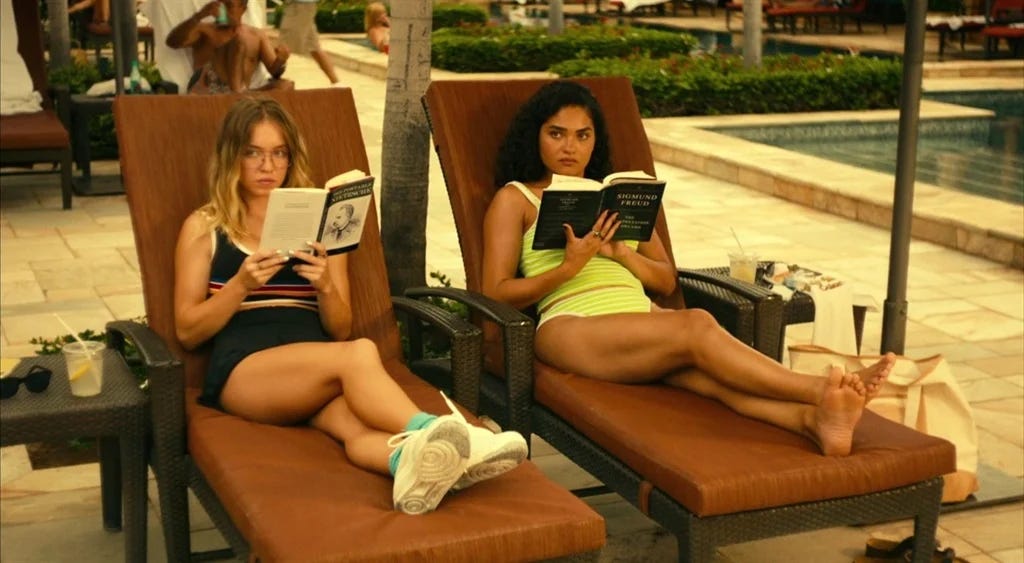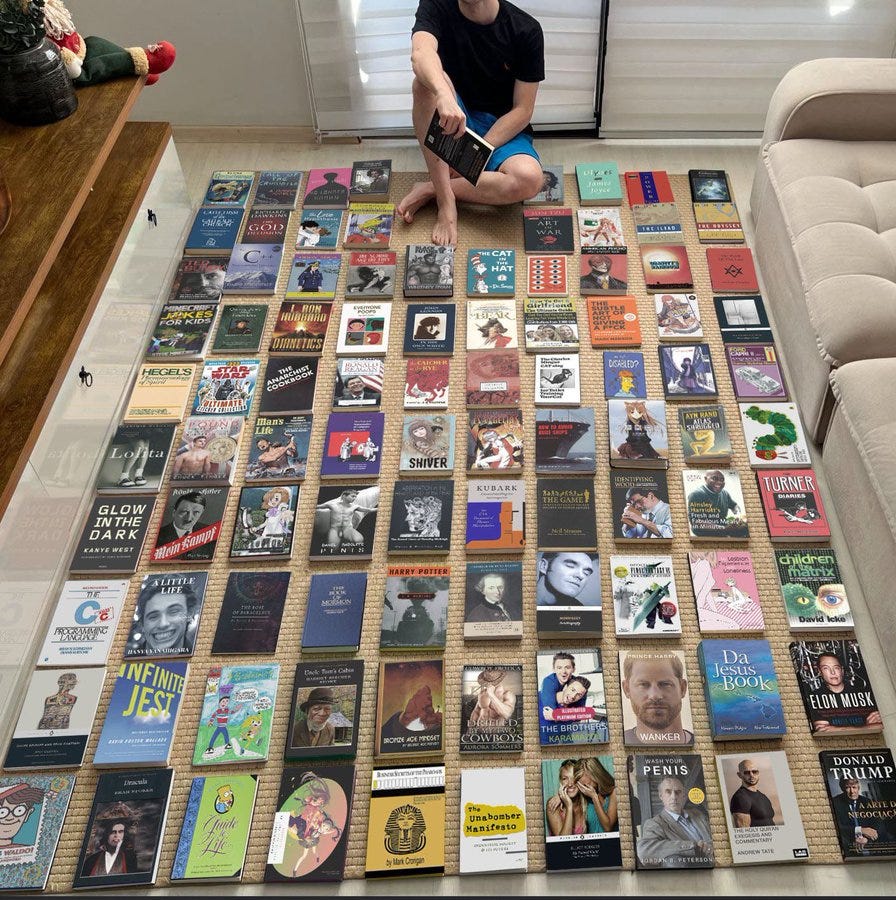Book-Objects
why sydney sweeney is holding paglia's sexual personae by the pool in white lotus s1 explained
I originally posted this in 2019, but wanted to update and republish it. For those interested in the original writing when I was 21 years old it’s available here.
When asking, “what is a book-object” the first question is “what is a book” which can be hard to answer. But once you’re holding something you know is a book, say Ulysses, you can establish what parts of it are not the book-object. When you refer to Ulysses as a book, you’re talking about the text Joyce wrote. The pages and binding, what you’re left holding in your hand if the words Joyce wrote floated into the ontological realm of the ideas, those aren’t what you care about when you discuss Ulysses. Those parts are the book-object.
But of course the words aren’t gone and that’s what makes the book-object special. Other art has associated art-objects, but they don’t work quite as well as the book-object. DVDs have a case and a disc with a picture on it and that’s a film-object. The resurgence of vinyl can be explained as an artificial attempt to create a corresponding physical music-object for the increasingly digitally-consumed art form. When you get all of your music from Spotify, you don’t acquire music-objects naturally. Often on TikTok you’ll see people who say they like vinyls as “big squares with art”, but it’s not just the album art, it’s the way the album art connects to music art that is an important non-physical object to them.
But to consume a vinyl record or a DVD you need a nonportable electronic device that converts the music-object into music or the film-object into a film. The book-object is unique among art-objects in that you can open it and the book is immediately accessible. When you carry around a book-object, you can access the book, its realm of ideas, at any time. Book-objects are portable and self-contained.
Because book-objects are portable and self-contained, they allow for powerful curation of identity. You can carry around a copy of Infinite Jest, and at any point you could be reading it. Now you are the type of person who reads Infinite Jest and the people around you know that and you know that they know that. You can kill John Lennon and be holding a copy of Catcher in the Rye and read it immediately after the murder, and that says something about you.
In physical space, book-objects can curate identity, but curation can be more powerful when immortalized in photos. Again, this is a property uniquely powerful to the book-object. You can take a picture of yourself with a frame of the movie you’re watching in the background, or post Spotify screenshot of the song you’re listening to alongside a landscape picture, but because a book-object is a more natural bridge between physical space and realm of art, it comes across more naturally in photos.
I’ll call these curated photos of book-objects within physical spaces “reading scenes”. When a sixteen-year-old girl takes a picture of The Bell Jar, the edition with the rose, next to her coffee on the glass table on her parents’ balcony on a cloudy day, she’s creating a reading scene, permanently capturing her moment of reading and also saying that this is how she reads. And because it’s how she reads, and because she’s touching the realm of ideas that the book contains, she’s saying this is who I am. The reading scene integrates the book-object alongside other objects to show how the book fits into her life.
When I first wrote this in 2019, Bronze Age Pervert’s manifesto Bronze Age Mindset was a hot topic. Upon release, there was a genre of BAP fan post that was a parody of the reading scene, where girls would pose on beaches reading Bronze Age Mindset. In these photos Bronze Age Mindset is used as a book-object to intentionally make a reading scene. There isn’t any implication that girls sat on the beach reading a Twitter nudist bodybuilder manifesto for a few hours, but that’s the text of the image. The subtext is that the kind of people who read Bronze Age Mindset can get girls to pose on the beach with a Twitter nudist bodybuilder manifesto for a few minutes. Identity is still being generated in these photos, but the first layer of the image is a joke on the type of reading scene that’s normally photographed.
This isn’t a uniquely self-aware book-object subversion. There’s tons of smaller jokes about book-objects. People post silly images of themselves reading books in unlikely situations all the time. People eat Infinite Jest as an object, as a performance art joke about how long it is. I had 4chan /lit/ repost tweet go medium viral, which contained a photoshopped image of an incomprehensible set of books together. Cat in the Hat to Mein Kampf to Infinite Jest to Bronze Age Mindset to The Art of the Deal in Portuguese. It makes a joke of the these sorts of staged reading scenes.
Book-objects in a group, as seen in this picture above, also create identity. On a bookshelf, book-objects are pressed next to each other, and instead of each individual book generating identity, it’s the matrix multiplication of every book object, “who would have read all of these books” instead of “who is reading this book”. People take photos of their bookshelves too, to create scenes of the person who would have owned these books. When politicians do Zoom interviews on TV, they have bookshelves in their background, not to project any particular books, because the shelves are usually too blurry to read, but just to let you know that they own book-objects, and maybe occasionally they sit down to touch the realm of ideas of the books.
I prefer purchasing books to checking them out from the library because of my lifelong collection of book-objects. I don’t think it’s entirely narcissistic, but it’s a bit narcissistic. I remember the books that I checked out from the library as a kid far less than the books I owned. If it’s part of my identity as a physical object on my shelf it becomes part of my memory and I understand it better.
Rainbow bookshelves are often mocked because they turn book-objects completely into objects. The book-object itself is sorted among other book-objects not at all by its similarity to other books, but by its similarity to other objects. The result is a very pretty bookshelf, but not one that’s deeply functional. You can buy bricks of books by the foot online in a certain color if you want your bookshelf to have more of that color, and you definitely aren’t going to be reading those random books. I don’t like that but I do like rainbow bookshelves. I totally empathize with the desire to have your books be sorted in a pretty way, because they exist within a physical space of your house. My way of sorting books by country of origin then by year of birth of the author is both prettier and more functional, it’s like a growing map of world literature on my walls, but not everyone can be like me.
People curate identity through all objects they carry with them, through objects they choose to carry in photos, through staged photos of the objects they keep in their home. There’s nothing unique about book-objects, but book-objects are uniquely potent, because they are self-contained and portable, but also because books are a special medium of art. The potency means that when reading scenes are weak people mock them online but I think that’s a bit cruel. Also because they’re potent they also allow people to project identities in an empowering way, letting the art flow through them. Fundamentally I think identity creation is a very empowering thing. Social media is totally rooted in the human desire to create identity. If the power of the book-object means people cling to the medium of books just a little longer I think that’s special too.





great piece. kindles are book object erasure!
the book as a consumer object, where sign value > use value
lets not single books out, this is the case for the whole of consumer society